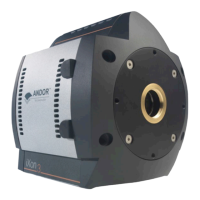Page 59
Features & Functionality
3.10 - ADVANCED PHOTON COUNTING IN EMCCDs
Photon Counting in EMCCDs is a way to overcome the multiplicative noise associated with the amplication process,
thereby increasing the signal to noise ratio by a factor of root 2 (and doubling the effective quantum efciency of the
EMCCD).OnlyEMCCDswithlownoiseoorcanperformphotoncounting.Theapproachcanbefurtherenhanced
through innovative ways to post process kinetic data. The industry-leading dark current and Clock Induced Charge (CIC)
specication of the Andor’s back-illuminated iXon3 897 model renders it uniquely suited to imaging by Photon Counting.
Photon Counting can only be successfully carried out with very weak signals, because as the name suggests, it involves
counting only single photons per pixel. If more than one photon falls on a pixel during the exposure, an EMCCD (or
an ICCD for that matter) cannot distinguish the resulting signal spike from that of a single photon event, and thus the
dynamic range of a single frame exposure is restricted to one photon.
Key Fact – To successfully photon count with EMCCDs, there has to be a signicantly higher probability of seeing
a ‘photon spike’ than seeing a dark current/CIC ‘noise spike’. The iXon3 897 has the lowest dark current/ CIC
performance on the market, yielding both lower detection limits and higher contrast images.
Under such ultra-low light conditions, ‘photon counting mode’ imaging carries the key benet that it is a means to
circumvent the Multiplicative Noise, also known as ‘Noise Factor’. Multiplicative noise is a by-product of the Electron
Multiplication process and affects both EMCCDs and ICCDs. In fact, it has been measured to be signicantly higher
in ICCDs. The noise factor of EMCCDs is well theorized and measured; to account for it you increase the shot noise
of the signal by a factor of square root 2 (~x1.41). This gives the new ‘effective shot noise’ that has been corrected for
multiplicative noise. The effect of this additional noise source on the overall Signal to Noise ratio can be readily viewed in
theS/Nplotsinthetechnicalnoteentitled‘EMCCDsignaltonoiseplots’.
Photon Counting Mode does not measure the exact intensity of a single photon spike, it merely registers its presence
above a threshold value. It does this for a succession of exposures and combines the individual ‘binary’ images to create
the nal image. As such, this mode of operation is not affected by the multiplication noise (which otherwise describes
the distribution of multiplication values around the mean multiplication factor chosen). The end result is that low light
images acquired through this mode of acquisition are improved by a factor of ~x1.41 Signal to Noise, compared to a
single integrated image with the same overall exposure time.

